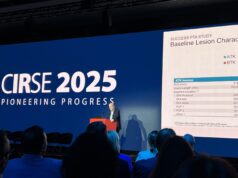
In a real-world retrospective analysis, recently published in JACC: Cardiovascular Interventions, the long-term mortality rate was lower after drug-coated balloon (DCB) angioplasty than after plain balloon angioplasty of femoropopliteal lesions. First author Tanja Böhme, senior author Thomas Zeller (both Universitäts-Herzzentrum Freiburg-Bad Krozingen, Bad Krozingen, Germany), and colleagues note that known co-morbidities, risk factors, and disease severity were identified as mortality predictors, but not paclitaxel.
Böhme et al cite the continuing debate surrounding the association between paclitaxel and late mortality in femoropopliteal interventions as the principal motivation behind their study.
They note that the conversion was sparked by the December 2018 meta-analysis by Konstantinos Katsanos (University of Patras, Patras, Greece) et al, which suggested an increased long-term mortality risk following femoropopliteal angioplasty using paclitaxel-coated devices.
“It remains unclear whether treatment of femoropopliteal lesions with a paclitaxel-coated DCBs leads to an increase in all-cause mortality in a real-world setting,” Böhme and colleagues note, adding that health insurance data-based analyses even suggest a survival benefit for patients with paclitaxel-coated DCBs, referring specifically to a presentation given by William Schuyler Jones (Duke Heart Center, Durham, USA) at the TransCatherTherapeutics 2018 conference (TCT; 21–25 September) and a paper by Eva Freisinger (University of Münster, Münster, Germany) et al published last year in the European Heart Journal.
The authors of the present study therefore set out to evaluate the long-term mortality after paclitaxel DCB use and plain balloon angioplasty of femoropopliteal lesions in real-world practice.
Böhme et al conducted a retrospective mortality analysis of patients with at least three-year follow-up who underwent balloon-based endovascular therapy of femoropopliteal lesions. Between January 2011 and June 2016, 7,357 patients with femoropopliteal lesions were treated with either a DCB or plain balloon angioplasty; 1,579 fulfilled the study criteria. They detail that 514 patients were treated with plain balloon angioplasty without crossover to a paclitaxel-coated device during follow-up, and 1,065 patients were treated with DCB angioplasty.
The primary endpoint of the study was the difference in all-cause mortality rate after plain balloon and DCB angioplasty. Secondary endpoints included three-year and five-year mortality rates, the relationship between DCB length as a measure of drug concentration and mortality, as well as search for mortality predictors including type of treatment, age, gender, hyperlipidaemia, diabetes mellitus, renal insufficiency, cerebral artery disease, coronary heart disease, and Rutherford-Becker class 1–3 versus 4.
The authors report that mortality incidence at mean follow-up of 52±20.5 months (median 51 months) was 27.8% after plain balloon angioplasty and 16.9% after DCB (p<0.001). Equally, for a cohort excluding patients over 80 years of age, the mortality rate after plain balloon angioplasty treatment was significantly higher (23.6% vs. 12.3%, p<0.001).
In addition, they note that DCB length was not correlated to mortality rate and, after propensity score matching, independent mortality predictors were plain balloon angioplasty treatment (p=0.035), age (p<0.001), stroke (p=0.025), and renal insufficiency (p=0.007).
In the discussion of their findings, the authors remark that, despite including a large number of patients with long-term follow-up in this single-centre study, they were not able to confirm the findings of the Katsanos et al meta-analysis. “In this real-world study, even after adjusting for confounding variables, we found a significant mortality benefit for patients treated with DCB,” they write.
On the subject of mortality, the authors note that death was most common due to cardiovascular events. However, in a significant number of cases, the cause of death remained unknown.
Comparing their results to those of the Katsanos et al meta-analysis, Böhme and colleagues write that the mortality rates of their study are higher, “as expected”. They cite a potential reason for this as being Katsanos et al’s focus on randomised controlled trials, which “usually exclude patients at higher mortality risk, such as patients with end-stage renal disease. In addition, only patients with a certain life expectancy are included—frequently excluding elderly and frail patients results in a selection bias”.
The authors note that the single-centre observational design of their study is a potential limitation but defend the retrospective data analysis, which they state “does not affect the primary study endpoint of all-cause mortality”. They also note that this study design represents strength in terms of excluding potential confounding variables due to a standardised prescription of secondary preventive drugs, such as statins and antiplatelet agents following the intervention. Another limitation they mention is that in almost half of the study population the cause of death could not be determined.
Böhme et al conclude that, in this real-world study, treatment of femoropopliteal lesions with DCB excluding patients with ischaemic wounds resulted in a survival advantage. However, they note that all-comers randomised clinical trials are necessary to prove this long-term survival benefit and to identify the potential cause, such as a mobility benefit resulting in a positive risk profile modification as a result of a patent vessel.













